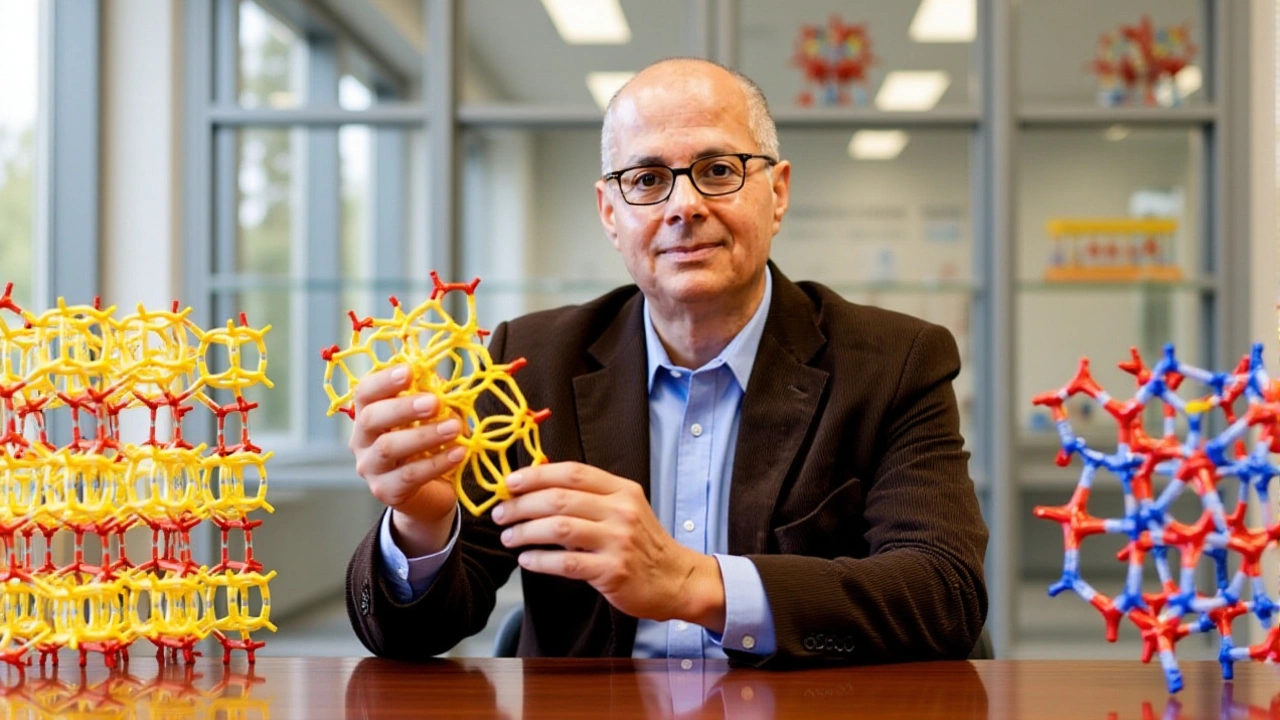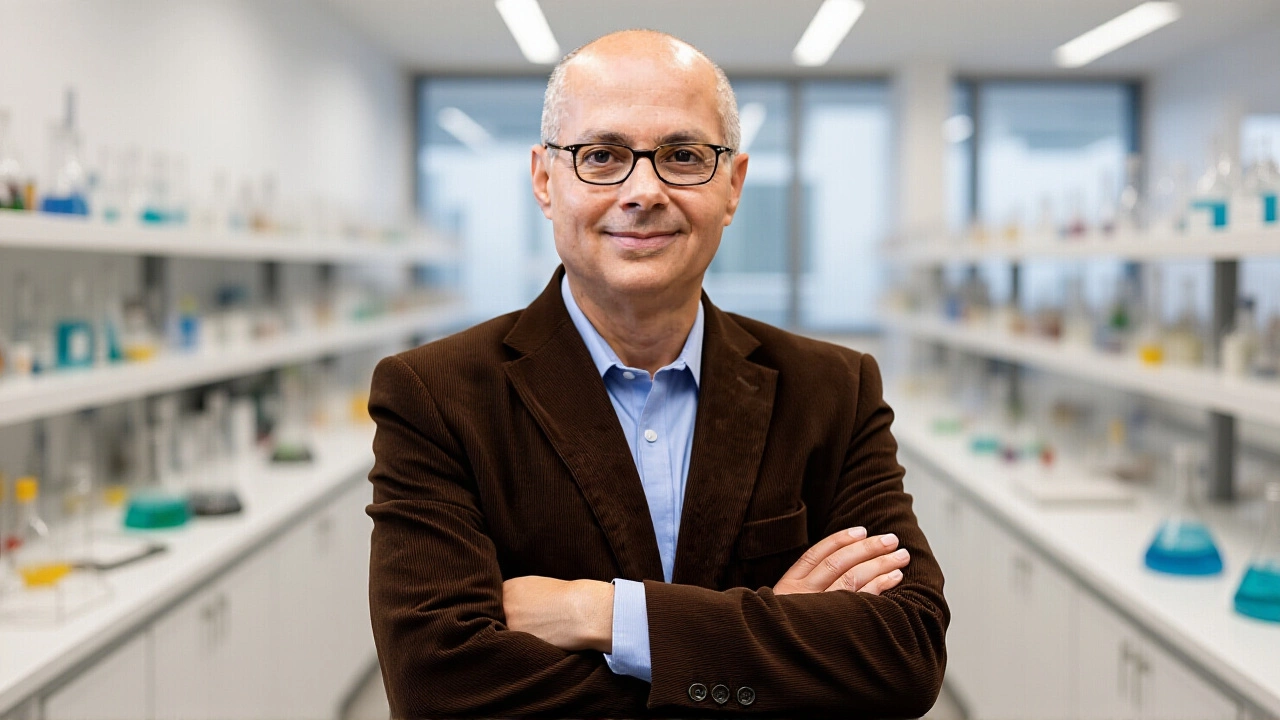When Omar M. Yaghi, a 60‑year‑old Jordanian‑American chemist, was announced as a 2025 Nobel Laureate in Chemistry, the world took a collective breath. The Royal Swedish Academy of Sciences revealed on 8 October 2025 that Yaghi would share the prize with Susumu Kitagawa of Kyoto University and Richard Robson of the University of Melbourne for pioneering metal‑organic frameworks (MOFs). The prize, worth $1,160,000 USD, will be split three ways, but the real reward is the global spotlight on a field that began in a modest Arizona lab three decades ago.
From Refugee Roots to the Nobel Stage
Born to Palestinian refugees in Amman, Jordan, Yaghi grew up in a household that "could barely read or write," as he recalled in an interview with Nobelprize.org. "My parents could barely read or write. It's been quite a journey; science allows you to do it," he said, his voice tinged with both humility and triumph.
His academic ascent started at the University of Arizona, but it was a faculty position at Arizona State University (ASU) in Tempe, Arizona, that set the stage for his Nobel‑winning work. From 1992 to 1998, Yaghi served as an assistant professor, a period he describes as "the most daring decade of my career."
Birth of Reticular Chemistry
It was at ASU that Yaghi met Michael O'Keeffe, a seasoned chemist then in his late forties and now a 91‑year‑old professor emeritus. O'Keeffe, an English‑born crystal‑structure guru, challenged the young Yaghi: "Can you synthesize this beautiful, complex crystal?" Yaghi replied, "Of course!" That moment sparked what Yaghi later named "reticular chemistry" – essentially stitching together molecular building blocks into extended, porous crystals.
Early skeptics at conferences muttered, "They won't be stable," "The frameworks will collapse when solvent is removed," and "They won't be porous." Yet the MOFs they created defied expectations, showing permanent porosity and the ability to adsorb gases at low pressures. As O'Keeffe later reflected, "They were – they adsorbed gases at low pressures and had 'permanent' porosity."
The Nobel Announcement
During a routine layover on 8 October 2025, Yaghi was pinged by a frantic assistant at University of California, Berkeley, where he has been a professor since 2005. "I was in the middle of changing flights when the call came," he told ABC15 News the next day. The Academy’s official press release, released from Stockholm, Sweden, described the laureates' work as “molecular constructions with large spaces through which gases and other chemicals can flow.”
At the same time, the Nobel Committee announced the 2025 Nobel Prize in ChemistryStockholm, cementing the award as the first chemistry Nobel tied to research performed, at least in part, in Arizona.

Why MOFs Matter: Real‑World Applications
The practical side of MOFs reads like a sci‑fi wishlist turned reality. UC Berkeley’s news office listed four headline uses: harvesting water from desert air, capturing carbon dioxide from the atmosphere, storing toxic gases, and catalyzing chemical reactions. In a 12 News interview on 9 October, Yaghi emphasized water harvesting: "Our materials can pull water vapor out of arid air, delivering drinkable water to those who need it most."
ASU President Michael Crow echoed that optimism, noting, "Their foundational designs have led to the creation of numerous structures worldwide and could pave the way for hydrogen energy, water collection techniques, and carbon‑capture technologies."
Industry analysts already cite MOFs in pilot projects ranging from carbon‑capture plants in Texas to emergency gas‑filter systems in Europe, illustrating how a discovery born in a university lab is reshaping global sustainability strategies.
Berkeley’s Growing Nobel Legacy
Yaghi becomes the 28th faculty member at Berkeley to earn a Nobel, joining a recent streak that includes John Clarke (Physics, 2025) and earlier icons like Jennifer Doudna (Chemistry, 2020) and Reinhard Genzel (Physics, 2020). The consecutive Nobel wins—Clarke on 7 October and Yaghi on 8 October—have turned the campus into an unofficial "Nobel corridor" for students and researchers alike.
For Yaghi, the honor is personal as much as professional. "My parents could barely read or write. It's been quite a journey," he said, recalling his childhood in a refugee camp. The story now serves as a beacon for under‑represented scholars worldwide, proving that groundbreaking science can emerge from any corner of the globe.

What’s Next for Reticular Chemistry?
Looking ahead, Yaghi and his co‑laureates plan to expand MOF libraries to target specific industrial challenges. A collaborative grant between Berkeley, Kyoto University, and the University of Melbourne, announced on 10 October, aims to develop MOFs capable of selective methane capture—a potential game‑changer for the natural‑gas sector.
Meanwhile, policy makers are taking notice. The European Union’s Green Deal cites MOFs as a promising tool for carbon‑neutral initiatives, and the U.S. Department of Energy has earmarked $150 million for MOF‑focused research under its Advanced Materials Initiative.
In short, the Nobel win not only validates past work but also accelerates a pipeline of innovations that could touch everything from clean drinking water in the Sahara to safer industrial chemistry in Detroit.
Frequently Asked Questions
How do metal‑organic frameworks help in water scarcity?
MOFs act like molecular sponges that pull water vapor from the air and condense it into liquid. Field tests in the Arabian desert have shown a single kilogram of MOF material can produce up to 2 liters of drinkable water per day, providing a low‑energy solution for remote communities.
What is reticular chemistry, and why is it important?
Reticular chemistry is the design of extended, porous structures by linking molecular building blocks with strong bonds. It underpins the creation of MOFs, enabling scientists to tailor pore sizes and chemical environments for specific tasks such as gas separation, catalysis, and sensing.
Who else benefited from Yaghi’s early work at Arizona State University?
Many of Yaghi’s graduate students and post‑doctoral fellows, including now‑leading researchers at Stanford and MIT, built their own MOF labs on the foundations laid at ASU. The university also launched the "Center for Porous Materials" in 2010, directly inspired by his discoveries.
What are the next milestones for the Nobel‑winning team?
The trio will focus on scaling MOF production for industrial use, targeting methane capture and hydrogen storage. Their joint grant aims to deliver a pilot plant by 2028 that can separate methane from natural‑gas streams with 90 % efficiency, a step toward greener energy.
How does this Nobel award affect the perception of chemistry research in the U.S.?
It shines a spotlight on interdisciplinary, materials‑focused chemistry, encouraging funding agencies to back long‑term, high‑risk projects. Universities are already reporting increased enrollment in chemistry and materials‑science programs, hoping to ride the wave of public interest sparked by the prize.
